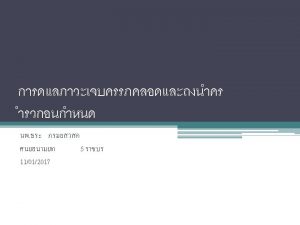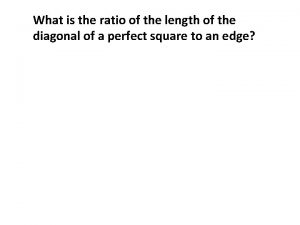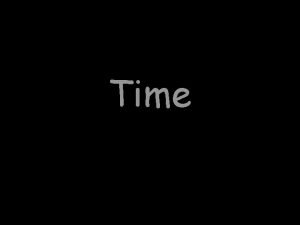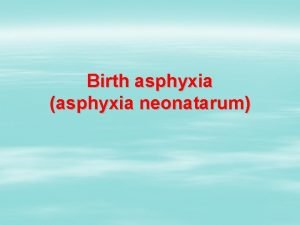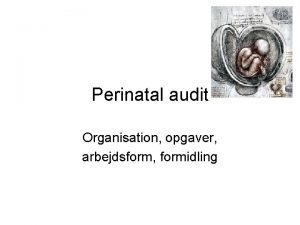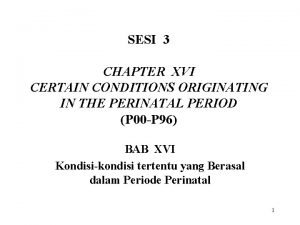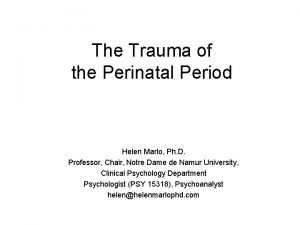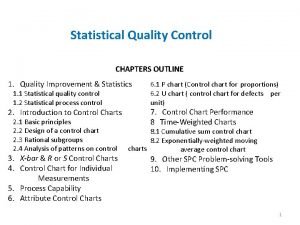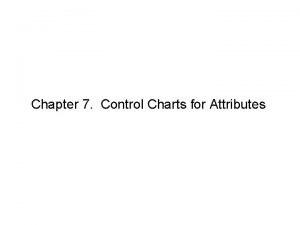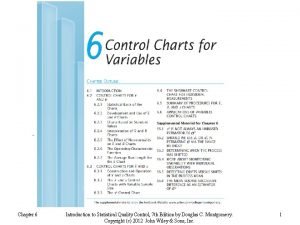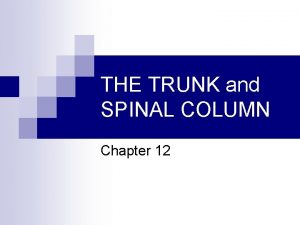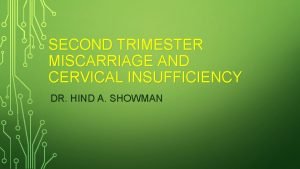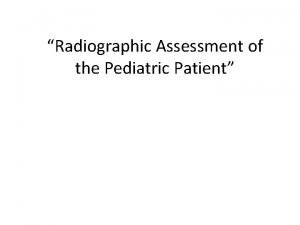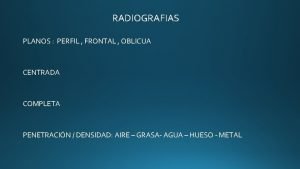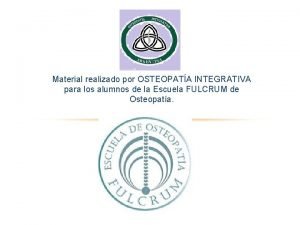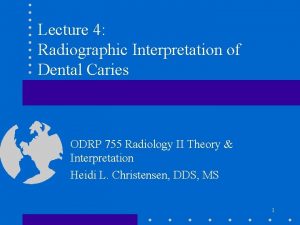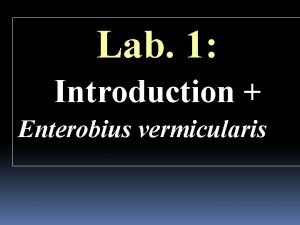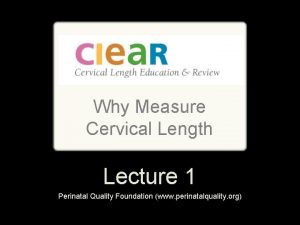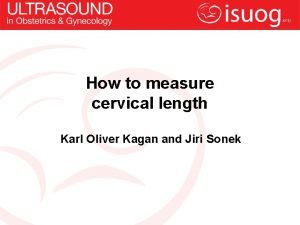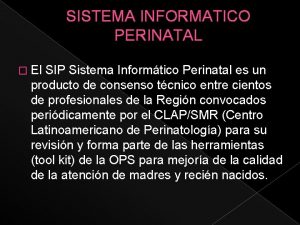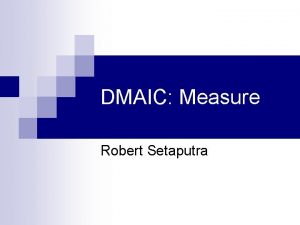How to Measure Cervical Length Perinatal Quality Foundation

































































- Slides: 65

How to Measure Cervical Length Perinatal Quality Foundation (perinatalquality. org)

Outline Normal Cervix Standard Cervix Image Criteria Transvaginal Examination Techniques Cervix Mobility Considerations Cervical Length Examination Protocols and Sequence Cervical Measurement Pitfalls References

Standardization Reliability Reliable cervix measurements during screening are required to achieve the potential of reduced preterm births. Reliable cervix measurements require: Ø Standard image criteria Ø Consistent examination protocols

I. Standard Image Criteria

Measurement of the Cervix Funnel Length Cervical Length B A A is the Funnel Length. B is the Cervical Length CA CP Record B as THE Cervical Length C Ant Lip should = C Post Lip Berghella, Ultrasound Obstet Gynecol 1997; 10: 161 Burger, Ultrasound Obstet Gynecol 1997; 9: 188

Normal Cervix Bladder Empty Internal Os Ext Os Fetal Head Posterior Cervix

Cervical Screening Measurement Image Criteria • Transvaginal Image • Cervix ~ 75% of the image • Anterior = Posterior Width • Maternal Bladder Empty • Internal Os Seen • External Os Seen • Cervical Canal Visible throughout • Caliper Placement Correct • Cervix Mobility Considered

Criteria 1: Transvaginal (TVU) Image Transabdominal Image CL = 37 mm. Transvaginal Image Same patient CL = 25 mm.

Transvaginal Cervical Sonography What is Wrong with This Picture? Illustration by James Cooper MD Berghella, in Callen 5 th edition 2008.

Transvaginal Ultrasound (TVU) No imaging barriers between transducer and cervix Empty bladder is exam standard Safe, comfortable, well-accepted Easier than trans-perineal imaging The Gold Standard Berghella, Clinical Obstet Gynecol 2003; 46: 947

AIUM Guidelines for Transvaginal Probe Care The endocavitary probe should be covered with a barrier (condom or probe cover). Users need to be aware of latex sensitivity and have non-latex barriers available. Users should wear gloves throughout the procedure. Care should be taken to clean hands and surfaces after the procedure. AIUM Guidelines for Cleaning and Preparing Endocavitary Transducers Between Patients, 2003.

AIUM Guidelines for Transvaginal Probe Care The probe should be cleaned with soap and water immediately after the procedure. High-level disinfection of the probe is required between patients. Allot the time specified on the product label for high-level disinfection. FDA has published a list of high level disinfectants for use in processing reusable medical devices. That list may be consulted to find agents that may be useful for probe disinfection. AIUM Guidelines for Cleaning and Preparing Endocavitary Transducers Between Patients, 2003.

Trans-Abdominal (TAU) Pitfalls • Fetal parts may obscure cervix • Bladder filling may elongate cervix and mask funnel • Long distance from probe decreases resolution • Manual pressure may compress lower uterine segment and mimic cervix

Can the Cervix Be Measured with Transabdominal Ultrasound (TAU)? Bladder volume has unpredictable effect on cervical length Mason, BJOG 1990; 90: 457 CL by TAU > TVU and not reliable To, Lancet 2004; 363: 1849 Hernandez-Andrade, J Maternal-Fetal Neonatal Med 2012; CL by TAU = TVU after training period Saul, J Ultrasound Med 2008; 27: 1305 CL by TAU < TVU and therefore reliable Stone, Aust N Z J Obstet Gynaecol 2010; 50: 523 Accuracy of TAU differs significantly according to whether a patient has a short cervix or a normal cervical length Hernandez-Andrade, J Maternal-Fetal Neonatal Med 2012: Transabdominal evaluation is the least reliable method ACR Appropriateness Criteria: Assessment of the Gravid Cervix, 2011.

Reasons Not to Screen by TAU Sensitivity of TAU for preterm birth is 8% Iams, N Engl J Med 1996; 334: 567 Owen, JAMA 2001; 286: 1340 Short Cervix missed on TAU Rust, Am J Obstet Gynecol 2001; 185: 1098 To, Lancet 2004; 363: 1849 Althusisius, Am J Obstet Gynecol 2001; 185: 1106 Fonseca, N Engl J Med 2007; 357: 462 Hernandez-Andrade, J Mat-Fetal Neonatal Med 2012; Major studies & RCTs over >10 years have all used TVU

Reasons Not to Screen by TAU Transabdominal US measurement of cervical length was unable to identify 57% of cases with a short cervix (<25 mm) as determined by transvaginal US. Transvaginal US cervical measurements were more reproducible than transabdominal US. Transabdominal US did not detect sludge and funneling in all cases. Transabdominal measurement overestimated cervical length by 8 mm among women with a short cervix and underestimated cervical length among women with a normal cervix. The accuracy of transabdominal US differs according to whether a patient has a short cervix or a normal cervix. Hernandez-Andrade, J Maternal-Fetal Neonatal Med 2012:

Criteria 2: Cervix Occupies 75% of the Image

Cervix Doesn’t Occupy 75% of Image

Cervix Doesn’t Occupy 75% of Image This image demonstrates a placenta previa and a measurement from the internal os to the placental edge.

Criteria 3: Anterior Width = Posterior Width

Criteria 3: Anterior Width = Posterior Width • The anterior cervical thickness is equal in width to the posterior cervical thickness. • The echogenicity is similar both anterior and posterior. • There is minimal concavity created by the transducer.

Anterior Width ≠ Posterior Width Note increased echogenicity anterior portion of cervix

Anterior Width ≠ Posterior Width Prominent concavity at transducer face

Anterior Width ≠ Posterior Width Prominent concavity at transducer face

Criteria 4: Empty Maternal Bladder

Maternal Bladder Not Empty

Maternal Bladder Not Empty

Criteria 5 & 6: Internal and External Os Well Seen

Criteria 5 & 6: Internal and External Os Well Seen

Pitfall: Uterine Contractions may obscure the internal os & mimic funneling

Pitfall: Uterine Contraction

Pitfall: Uterine Contraction

Neither Os Seen Well

Too much pressure: Neither os seen well

External Os Not Well Seen

Internal Os Not Clear

Criteria 7: Cervical Canal Completely Visible Throughout

Cervical Canal Visible Throughout This is an example of an exception to the bladder edge being directly above the internal os

Cervical Canal Not All Visible

Cervical Canal Not Visible Throughout

Criteria 8: Caliper Placement Correct Bladder Ext Os Int Os Fetal Head Posterior Cervical Lip

Caliper Placement is Correct

Where to Put the Calipers? § Where the anterior & posterior walls of the canal touch § Not outer-most edge § Spend enough time to see whether a small echolucent area is stable, or is going to open up YES NO

B = Funnel A = Cervix Length A B Cervix Length A + B

Caliper Placement Incorrect Remember not to include funnel in Cervix length measurement

Caliper Placement Incorrect

How to Measure a Curved Cervix: Don’t Trace to Measure the Cervical Length Why Not?

How to Measure the Curved Cervix: Use Multiple Measurements

How to Measure the Curved Cervix: Use Multiple Measurements

Criteria 9: Cervix Mobility Considered The Cervix is Dynamic Examinations must take cervical changes into account

Local Contraction - Single Examination CL 33 mm CL 7 mm Clue = Debris Guzman, Obstet Gynecol 1998; 92: 31

Dynamic Technique Withdraw probe until blurred / Reapply Enlarge image (2/3 of screen) Measure Ext Os Int Os along endocervical canal Apply fundal or suprapubic pressure Obtain 3 measurements, use shortest best Total exam time about 5 minutes Berghella, Clin Obstet Gynecol 2003; 46: 947

II. Consistent Examination Protocols

Quality Operator Considerations Experience w/ Transvaginal Exams Recent Education in Standard Cervical Image Criteria Practice in obtaining symmetrical cervical imaging (50 or more exams before proficient studies) Documentation of Inter-observer variability of 7 -10% or less Burger, Ultrasound Obstet Gynecol 1997; 9: 188 Berghella, Ultrasound Obstet Gynecol 1997; 10: 161

Pre-exam Considerations • Check the equipment • Transducer appropriately cleaned w/ soap & water + soaked for sufficient time for high-level disinfection • Use standard 5 to 7 MHz endovaginal probe • Use the “EV” Endo. Vaginal setting (Not OB or ABD) • Ask patient about latex sensitivity • Empty maternal bladder • Void just before the exam • If bladder is seen to be large, stop exam & void again

Transvaginal Exam Considerations Some women prefer to insert probe themselves Guide along anterior fornix for sagittal view of cervix Look in top ½ of image for maternal bladder & AF Find these landmarks in sequence: Amniotic Fluid & Fetus then Bladder Internal Os Cervical Canal, and then External Os Rotate probe to see best long axis view of the canal Withdraw probe until image blurs to reduce compression from the transducer, then …

Measurement Technique • Relax probe pressure until image begins to blur, then reapply just enough pressure to create best image • Visualize standard criteria • Measure CL repeatedly until is < 10% • Record the “Shortest Best Measurement” • Discard poor measurements – Do Not Average

Reporting Considerations What is “Shortest Best” ? Take repeated measurements until you get 3 that all meet criteria (anterior = posterior thickness, landmarks seen) that vary by < 10% Of these 3 excellent images, record the SHORTEST one – not the one you think is “prettiest” – we want to minimize subjective variation

Trouble Finding a Good Image? § Start over by relaxing pressure & finding landmarks § Find lowermost edge of the empty bladder – internal cervical os should be directly below § Cx axis may not lie in mid-plane of torso § Image should fill 75% of the screen

Cervical Scan Technique 1 st measurement may be longer than subsequent measurements Discard it Apply pressure to find funnel and assure best measurement Use mild fundal and then suprapubic pressure Remember to reduce probe pressure while fundal and suprapubic pressure applied

Summary I. Standard Image Criteria II. Consistent Examination Protocols

Technique Empty maternal bladder. Using TVU find the internal os, external os, cervical canal and endo-cervical glands. Avoid undue pressure on the cervix. Anterior width = Posterior width. The cervix should occupy > 75% of the image. Measure the closed portion of the cervix. Perform 3 measurements over > 3 minutes. Record the Shortest length that Meets Criteria. Not the average length, and Not the prettiest picture

TVU Pitfalls Technical Full bladder Too much pressure Failure to visualize entire cervical length Incorrect caliper placement Exam too short to visualize dynamic cervix changes Anatomic Contraction Underdeveloped LUS

Other Factors Affecting Cervical Measurement Gestational age: Lower segment of uterus may be difficult to distinguish from cervix until somewhere between 16 and 20 weeks If can’t tell at 16 -18, ask her to come back at 18 -20 wks Maternal bladder volume always an issue – empty it Duration of scan – A scan < 3 minutes is inadequate OPERATOR experience & training Set aside whatever you were taught We all have to measure the cervix the same way.

For further information www. perinatalquality. org 405 -753 -6534
 Clear perinatal quality
Clear perinatal quality Indiana perinatal quality improvement collaborative
Indiana perinatal quality improvement collaborative Cervical length chart in mm
Cervical length chart in mm What is the ratio of the length of to the length of ?
What is the ratio of the length of to the length of ? Measure arc length
Measure arc length Unit 5 lesson 1 measure length
Unit 5 lesson 1 measure length What units do we use to measure length
What units do we use to measure length Meniscus lab equipment
Meniscus lab equipment Gibbons jacobean city comedy download
Gibbons jacobean city comedy download Air temperature
Air temperature Raft foundation vs pad foundation
Raft foundation vs pad foundation Foundation standard 1 academic foundation
Foundation standard 1 academic foundation Perinatal matrices grof
Perinatal matrices grof Perinatal mortality rate
Perinatal mortality rate Perinatal asphyxia
Perinatal asphyxia Neonatarum
Neonatarum Perinatal audit
Perinatal audit Uyarıcı zenginliği ve yoksunluğu nedir
Uyarıcı zenginliği ve yoksunluğu nedir Certain conditions originating in the perinatal period
Certain conditions originating in the perinatal period Ccqi perinatal standards
Ccqi perinatal standards South dakota perinatal association
South dakota perinatal association Perinatal risk factors
Perinatal risk factors Helen marlo
Helen marlo Ruta materno perinatal
Ruta materno perinatal Perinatal period
Perinatal period Hie
Hie Average run length in quality control
Average run length in quality control Average run length in quality control
Average run length in quality control Average run length in quality control
Average run length in quality control Measure page quality
Measure page quality Data quality dimensions
Data quality dimensions Era of quality at the akshaya patra foundation
Era of quality at the akshaya patra foundation Quality culture vs traditional culture
Quality culture vs traditional culture Quality assurance vs quality control
Quality assurance vs quality control Quality management pmp
Quality management pmp Quality metrics pmp
Quality metrics pmp Quality improvement vs quality assurance
Quality improvement vs quality assurance Compliance vs quality
Compliance vs quality Basic concept of quality management
Basic concept of quality management Quality gurus of tqm
Quality gurus of tqm Quality is free
Quality is free Old quality vs new quality
Old quality vs new quality Scoliometer
Scoliometer Endocervical polyp
Endocervical polyp Cervical lateral flexion
Cervical lateral flexion Scalenes
Scalenes Quadrangular membrane
Quadrangular membrane Spinal nerves
Spinal nerves Intumescência cervical da medula espinhal
Intumescência cervical da medula espinhal Cervical fascia
Cervical fascia Cervical circulage
Cervical circulage Longus colli action
Longus colli action Branches of subclavian artery
Branches of subclavian artery Cervical hivd
Cervical hivd Hip rom
Hip rom Cervical burnout
Cervical burnout Cervical burnout
Cervical burnout Sacro verticalizado
Sacro verticalizado Cervical enamel projection
Cervical enamel projection Icares sti
Icares sti Uterotrophins
Uterotrophins Ligamento interpleural de morosow
Ligamento interpleural de morosow Defence mechanism of female genital tract
Defence mechanism of female genital tract Cervical burnout dental
Cervical burnout dental Life cycle of enterobius vermicularis
Life cycle of enterobius vermicularis Raw egg white cervical mucus
Raw egg white cervical mucus


